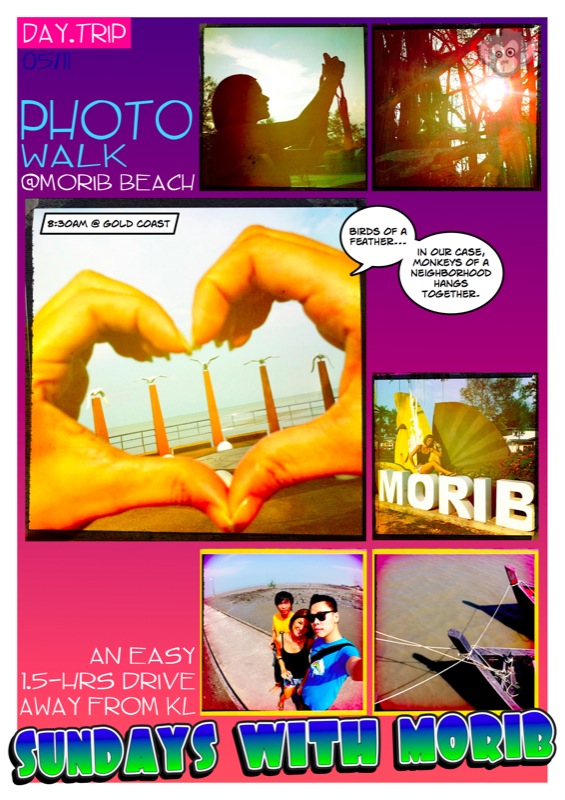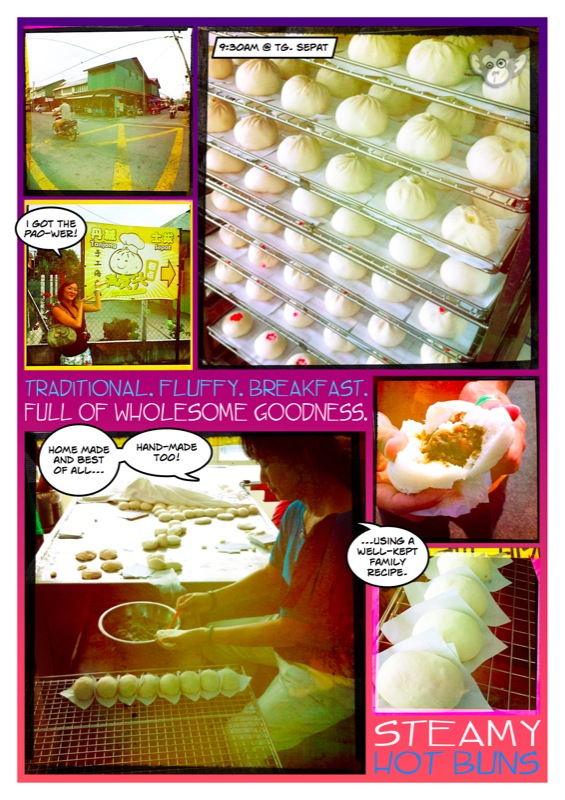Belonging to one Ms. Ciki, it sprang off with the chirpiest of good morning pleasantries. Groan. Why do all morning calls have to sound so chirpy? But even if I wanted to, it was too early to launch into verbal assaults of any kind. And there is no way I could bark (waitamin, monkeys don't bark) at this sweet perky thing who I vaguely remember saying "Yes" to just a couple hours ago. I painfully made my way out of bed...... slowly. I really wanted to get up, really!
Half and hour later, Cumi dan Ciki pulled up on my driveway and off we went for another monkey adventure. Thanks for asking me along!

I. MORIB BEACH
Approximately, 80-minutes drive later we found ourselves surrounded by whispering casuarinas and swaying palms which visually combs the golden sandy beach and from the top of the newly built esplanade, we watched small crabs scuttle away and disappear into the sand below us. This is the coast of Morib, formerly a popular seaside attraction located on the southern parts of Selangor, Malaysia. Cyclist and day-trippers seems to be drawn to its coast, spreading out a mat and resting to a picnic breakfast beside the shady grove.
Morib Beach (Pantai Morib) also holds historic significance, noted as one of the first landing points on the west coast of Malaysia for the British and Indian Army liberation forces at the end of World War II in September 1945, marking the end of the Japanese Army's occupation of Malaya. Also located around the beach are the ruins of old government buildings and the royal graves at Jugra, including an abandoned palace from the 1800's but we were too hungry to explore them.

II. TANJUNG SEPAT
A further 15-minute drive from Morib along the Straits of Malacca, lead us to the town of Tanjung Sepat. Primarily, this sleepy hollow is a fishing town. Most of its residents are somehow connected to the fishing industry, although the relative importance of fishing to the economy today is dwindling due to pollution in the Straits itself.
While strolling around in search of breakfast, we stumbled upon Hai Yew Heng, a local pau or bao (Chinese steamed bun) producer. Frankly, prior to this, I've not heard of them. But what we gathered from the framed up newspaper and magazine clippings is that they are very popular, drawing in visitors from all over including celebrities as far as Hong Kong. The writings on the wall claim that the buns are so popular that a quota is imposed to just two pau per customers. Business owner Mr. Lee Chin Teck who inherited the business from his father explains that they do so in order to meet the high demand and every walk-in customer would get a chance to savour their specialty, especially during weekends and festivals when up to 50 tour buses would make a stop at their factory.
This is also the same article that claims customers would have to pre-order their buns via telephone before arriving or risk a 2-hour wait. Either it's full of PR horseshit or it was just our lucky day. Plenty of buns to spare and not a tour bus in sight. Then again, it was still early. The crew in the kitchen were busy preparing trays upon trays of pau doughs and stuffing them with a variety of homemade fillings, perhaps in anticipation of a larger afternoon crowd later. Apparently, they makes and sell over a thousand buns a day. Impressive.
Hai Yew Heng produces Hainanese styled pau, which are larger and flater than their Cantonese cousins. Although the primary dough is mixed by modern machineries, they are still manually hand-flattened and filled with 豆沙(red bean), 加央(kaya, or coconut jam), 花生(peanut), 生肉(sang yuk, or pork meat with egg), 菜(vegetables) and 梅菜(mui choy, or preserved vegetables and minced pork). We were told that local produce are sourced and used - the pork comes from the nearby pig farms, while the kaya is made from local chicken eggs and coconuts harvested from the surrounding orchards as well.
We found the steaming hot buns to be fluffy, light, airy with a warm sweet scent of cooked yeast. Connoisseurs of dim sums might like to know that the pau has the texture a Fatt Go (steamed rice cake) with the chewy bite of a Ma Lai Go (steamed egg cakes). Our favourite of the day would have to be the Mui Choy variety, stuffed with a tasty savory and sweet filling. The eggy and aromatic Kaya stuffed bao was also a hit. However, all is not gold, the signature Sang Yuk pau didn't find favour in us as it was too peppery for our taste and a tad too dry. Also, do be prepared to fork out about RM1.10 to RM 2.20, which is possibly more expensive than what you'd find in the city.
Hai Yew Heng
No. 405, Jalan Pasar
42800 Tanjung Sepat
Kuala Langat, Selangor Darul Ehsan.
Tel: +6012-272 9009
Operating Hours: Mondays to Fridays 1.00pm - 6.00pm | Weekends and Public holidays 10.00am - 6:00pm

III. Banting
En route back to KL, we stopped by at Banting which is the principal town of the district of Kuala Langat. Banting has a reported population of slightly over 48,000 residents and is situated on the banks of Langat River (Sungai Langat in Malay). It is a Rest Town or Bandar Persinggahan on the old Federal route since it is close to the historical Bandar Jugra, the former royal town of Selangor.
The afternoon sun was scorching down on us and Cumi knew the exact way to cool us down. We chanced upon a tiny little shack located next to the open-air taxi terminal in the heart of town. The stall is surrounded by sweaty locals waiting for their orders. Standing on the other side of the stall is a smiley Indian-Muslim chap, presumedly Kamarudin since his name was plastered on all sides of his stall. He was a friendly guy, never once too busy to take down orders or look you in the eye and flash his pearly whites. Everyone hovers around the front of his stall and silently watch his every move.
Like clockwork, he begins by taking an orange bowl with his left hand, scoop in a couple tablespoon of red beans and magenta sago pearls, then swiftly placing the bowl under a rustic wooden shaver which has seen better days. Then using his right hand, he laboriously move the block of ice back and forth over the sharp blade very quickly, several times over. Pure white snow starts to fall into the bowl underneath until it mounded into a miniature mountain before he pulls the bowl out and ladles in a long scoop of santan (coconut milk) concocted with weeny strands of green pandan-flavoured mung bean and rice flour 'noodles'. And, finally, he drizzles a good amount of gula Melaka (coconut palm sugar syrup) right on top before serving the dessert.
Being the wide eyed out-of-towner that I am, I switched on the Hipstamatic app and started shooting away to the amusement of the locals. One of the man asked where we was from in Bahasa Melayu and continues to tell me that "Inilah cendol paling best di Banting. Memang top!" ("This is the best Cendol in all of Banting!") with two thumbs up as if his words had no conviction whatsoever.
One sip of this Cendol was all it took for us to be fans. Any dish this uncomplicated requires top-notch ingredients. While there is not much one can do about the quality of the ice, but one can't possibly argue with the extra rustic sensation one get from manual hand-shaven ice or the tiny hand made pasta which was light, slightly bouncy, toothsome to the bite, and fragrant with pandan leaf. The noodles, red bean and sago jelly married perfectly with the fresh and slightly salty and coconut milk; and the rich and complex caramelised flavours of the palm sugar syrup too. And it cost all but RM1.00 per bowl. What a steal.
Cendol Banting Kamarudin
Taxi Terminal along Jalan Sultan Abdul Samad,
Kuala Langat, Selangor Darul Ehsan.
Tel: +6016-6527456
Hahaha... I guess some monkeys (looks at Cumi & Ciki) are far chirpier than other monkeys (looks at another non-lil, non-fat monkey despite his moniker to the contrary) on weekend mornings. :P
ReplyDeletewell worth that wake up call & I love that statement of why monkeys don't bark!
ReplyDeleteI want some cendol now!
Love the way you described Hainanese vs Cantonese - for awhile I was thinking if I were less larger or flater than my fellow cousin - the Hainanese. Only I realized it is about pau.
ReplyDeleteFabulous honey.. feeling the LOVE right now.. rolling in the deepest part of Morib indeed;)
ReplyDeleteWOOF WOOF!
gosh, yeah, i don't think i'd be able to wake up at 8.30 even. but at least u guys are out exploring and having fun, while i sleep my life away, heheh :D (btw, my mom's side is hainanese too, but unfortunately for me, my family has no secret recipes for steamed buns!)
ReplyDeleteHmpf. I dun wanna read about cendol. Cis.
ReplyDeleteSo cute the pic of the monkey on the Morib sign. Like the 1960s liddat.
ReplyDeletehi,
ReplyDeleteI went there as well recently, heard there is a longan farm around there, but couldn't find which entrance to turn in from the main road
i missed going on a road trip :( you guys looked like have loads of fun
ReplyDeleteauh, cendol looks goooooodd.
ReplyDeletei love road trips. :)
Next time can I join road trips like this?! No wonder Ciki mentioned about a pau escapade ...
ReplyDeleteHow good are these buns! I feel like picking one up and yum. Looks like a fun day trip and good times by all :)
ReplyDeleteNice cendoi. Must try the Miracle Kangen water also. Special invitation only. Let me know if you are keen in testing it. Can see it here www.youtube.com/xtremexn
ReplyDeleteguffaw, i have the pao-er...you so crever la monkey boy
ReplyDeletecan u please bring my kids on a day trip to morib and sepang gold coast